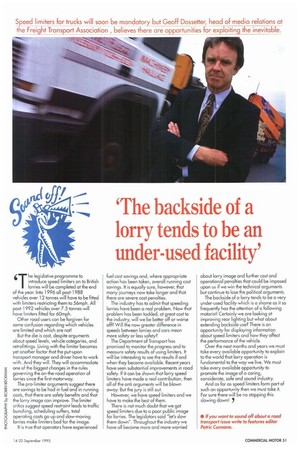The backside of a lorry tends to be an under-used facility'
Page 63

If you've noticed an error in this article please click here to report it so we can fix it.
6 he legislative programme to
introduce speed limiters on to British lorries will be completed at the end of the year. Into 1996 all post-1988 vehicles over 12 tonnes will have to be fitted with limiters restricting them to 56mph. All post-1992 vehicles over 7.5 tonnes will have limiters fitted for 60mph. Other road users can be forgiven for some confusion regarding which vehicles are limited and which are not!
But the die is cast, despite arguments about speed levels, vehicle categories, and retrofittings. Living with the limiter becomes yet another factor that the put-upon transport manager and driver have to work with. And they will. They will accommodate one of the biggest changes in the rules governing the on-the-road operation of lorries since the first motorway. The pro-limiter arguments suggest there are savings to be had in fuel and in running costs, that there are safety benefits and that the lorry image can improve. The limiter critics suggest speed restraint leads to traffic bunching, scheduling suffers, total operating costs go up and slow-moving lorries make limiters bad for the image. It is true that operators have experienced fuel cost savings and, where appropriate action has been taken, overall running cost savings. It is equally sure, however, that many journeys now take longer and that there are severe cost penalties. The industry has to admit that speeding lorries have been a real problem. Now that problem has been tackled, at great cost to the industry, will we be better off or worse off? Will the now greater difference in speeds between lorries and cars mean more safety or less safety? The Department of Transport has promised to monitor the progress and to measure safety results of using limiters. It will be interesting to see the results if and when they become available. Recent years have seen substantial improvements in road safety. If it can be shown that lorry speed limiters have made a real contribution, then all of the anti arguments will be blown away. But the jury is still out. However, we have speed limiters and we have to make the best of them.
There is not much doubt that we got speed limiters due to a poor public image for lorries. The legislators said "let's slow them down". Throughout the industry we have all become more and more worried about lorry image and further cost and operational penalties that could be imposed upon us if we win the technical arguments but continue to lose the political arguments. The backside of a lorry tends to be a very under-used facility which is a shame as it so frequently has the attention of a following motorist! Certainly we are looking at improving rear lighting but what about extending backside use? There is an opportunity for displaying information about speed limiters and how they affect the performance of the vehicle. Over the next months and years we must take every available opportunity to explain to the world that lorry operation is fundamental to the way we live. We must take every available opportunity to promote the image of a caring, considerate, safe and sound industry. And as for as speed limiters form part of such an opportunity then we must take it. For sure there will be no stopping this slowing downl
• if you wont to sound off about a rood transport issue write to features editor Patric Cunnane.
















































































































